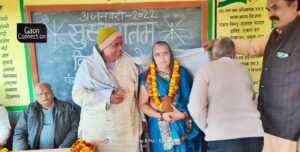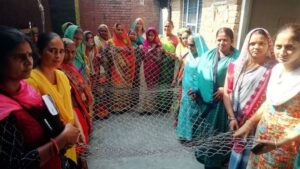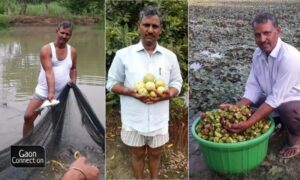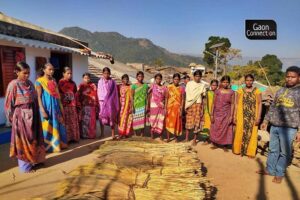In a first-of-its-kind initiative across India, the Odisha government has decided to provide pulses, millets, oilseeds, and even fruits and vegetables to the beneficiaries of the government welfare schemes, such as the mid day meal and public distribution system (PDS). These food items will be offered in addition to the monthly quota of rice given under the welfare schemes of the state government.
“Every state is providing rice and wheat, but we want to diversify. We are still in the stage of finalisation, but such an initiative was needed,” Suresh Kumar Vasishth, secretary, Department of Agriculture & Farmers Empowerment Department, Government of Odisha, told Gaon Connection.
“Through this initiative, we are also focussing on women empowerment,” the secretary added. The initiative is expected to employ women self-help groups to provide these food items, and also address malnutrition and anaemia among women and children in the tribal dominated state.
According to a notification issued by the Department of Agriculture & Farmers’ Empowerment on May 21, the state government has formed a technical committee for developing a roadmap for inclusion of millets, pulses, oilseeds, fruits and vegetables in the Integrated Child Development Scheme (ICDS), mid day meal scheme (MDM), and the PDS.
The central government’s ICDS is the world’s largest programme for early childhood care and development, with over 158 million children (2011 Census) in the 0-6 years age group, and pregnant and lactating mothers in the country registered under it. It offers six services: supplementary nutrition, preschool non-formal education, nutrition and health education, immunisation, health check-up and referral services, through 1.36 million functional anganwadi centres spread across all the districts in the country (as of June 2018).
Mid Day Meal Scheme, commonly known as the MDM Scheme of the Ministry of Education, has 115.9 million school children enrolled under it who are offered one hot cooked meal a day at their schools.
Also Read: Excluded by marriage: ‘Over a million women in Odisha left out of PDS’
Activists welcome the move
The Right to Food Campaign, a non-profit working on food rights of citizens, has been demanding inclusion of pulses in PDS for a long time. Three months back on June 12, the non-profit wrote to Chief Minister Naveen Patnaik demanding inclusion of free dal (pulses) and oil in the government’s PDS besides rice and wheat provided to the families. In Odisha, more than 34 million people are covered under the public distribution system of National Food Security Act, 2013, and state food security schemes.
“The decision to include pulses, millets, oilseeds, fruits and vegetables in welfare schemes is a welcome move. At least the discussion has started. The Odisha government has a history of initiating such steps,” Sameet Panda, lead member, Right to Food Campaign, Odisha, told Gaon Connection.
“It is important to add non-cereals in the meals offered at the anganwadi and school meal programmes to address the protein deficiency which is a major cause of malnutrition in the state,” said Panda. Also children lack different minerals, micronutrients and fat which can be addressed through a balanced diet consisting of dal, oil and fruits, vegetables, he added.
The Union health ministry’s ‘National Family Health Survey-4: 2015-16’ showed that in Odisha, every second (51 per cent) woman between 15 and 49 years of age is anaemic. Further, 44.6 per cent of kids between six and 59 months are anaemic, and every third (34.1 per cent) under-5 child is stunted (height-for-age).
As per the 2011 census, 34.64 million — around 82 per cent of the state’s population — is covered under the National Food Security Act, 2013. It is believed that a large chunk of the malnourished tribal population will benefit from the new initiative.
Also Read: ‘Rice and wheat in India are lot less nutritious than they were 50 years ago’
Crop diversification and millets mission
Four months back, on May 21, a technical committee comprising 11 departments of the state government including agriculture, ICDS, WASSAN (Watershed Support Services and Activities Network), were asked to prepare a roadmap for inclusion of pulses, oilseeds, fruits and vegetables in the welfare schemes.
Official sources told Gaon Connection that through two government schemes – Odisha Millets Mission, and crop diversification under Mega Irrigation Lift project – the novel initiative will be implemented. It will help diversify crops and promote consumption of millets and pulses through the welfare schemes.
The crop diversification programme will be implemented under the Mega Lift Irrigation projects in 18 districts, and the Odisha Millets Mission will be scaled up in 15 districts including Malkangiri, Koraput, Kalahandi, Ganjam, Mayurbhanj.
“The government of Odisha is preparing a roadmap to move away from paddy to other high value crops such as millets, pulses, oilseeds, cotton, vegetables, etc. In order to ensure transition is sustainable, it is important to have a consumption and marketing based models,” Bhubaneswar-based Dinesh Balam, member of the state technical committee, told Gaon Connection. He is the associate director of WASSAN – a national-level resource support organisation working with the state government’s Odisha Millets Mission to revive millets in farms and on plates.
Scaling up millets consumption through ragi laddus
Millets form a substantial part of the diets and the cropping system in the tribal areas of Odisha. To further promote millets, the state government launched the Odisha Millets Mission in 2017. Under this flagship programme, the state government claims to be the first state in the country to include ragi (finger millet) laddu for preschool children (in the age group of 3-6 years) in the ICDS through support of the District Mineral Foundation funds.
“In the Odisha Millets Mission, inclusion of ragi laddus has been piloted in two districts [Keonjhar and Sundergarh] since 2020 under technical guidance of CSIR-CFTRI (Central Food Technological Research Institute). Around 1.2 lakh [120,000] children have been served these laddus in the last one year,” said Balam.
“We give 20 grammes of ragi laddu under the ICDS. This is proposed to be scaled up in the 15 OMM districts in phased manner. Further to this, pilots are being proposed to explore inclusion of ragi based THR (1 kg/month) and little millet based khichadi in ICDS, MDM and Welfare hostels,” informed the associate director of WASSAN. “But for that we need a lot of capacity building as there are thousands of anganwadis across the state,” he added.
In Odisha, there are 72,587 functional anganwadi centres. About 1.8 million children aged between six month and three years, 1.6 million preschool children between three years and six years, and more than 700,000 pregnant and lactating women are registered with these centres.
More than five million beneficiaries in 15 districts of the state are part of the Odisha Millets Mission model. “This year, we have at least one lakh seventeen thousand farmers who are directly benefiting by doing production of millets, and fifty lakh people are covered by it through the PDS [in 15 districts],” Ashima Chaudhary, state coordinator, WASSAN, told Gaon Connection.
Predictably, Odisha government’s millets model is being appreciated at the national level too. Two days back on September 15, Odisha was declared the ‘Best Millet Promoting State’ under ‘Poshak Anaj Awards’ by Indian Council of Agricultural Research (ICAR), Indian Institute of Millets Research (IIMR) and Food and Agriculture Organization of the United Nations (FAO).
Congratulate @krushibibhag, tribal farmers, @mission_shakti SHGs, FPOs, Line Depts, @NCDS_BBSR, NGO partners, and @WASSANIndia for their contribution towards making #Odisha the ‘Best Millet Promoting State’.#OdishaLeads https://t.co/DALZYfT7sZ
— Naveen Patnaik (@Naveen_Odisha) September 15, 2021
The central government has asked all the states across the country to adopt the Odisha Millets Mission model for promotion of millets, pulses and oilseeds.
Empowering tribal women and farmers
The technical committee has considered options such as sprouted green grams and ragi based snacks to be provided in the government schemes. It was also considered that these products shall be directly procured from farmers through women self help group and farmer producer organisations and shall be further processed and supplied for inclusion in concerned food schemes through self help groups.
“This will ensure benefits of the crop diversification interventions directly to farmers and women. Procurement will be done from farmers. Value addition, processing, supply will be ensured by women collectives. This will further women empowerment and aid in increasing the income of farmers,” said Balam. So far, 262 self help groups are employed in consumption and value addition of millets as part of the Odisha Millets Mission.
“A pilot is being proposed to be taken up. Based on results, this can be further scaled up,” he added. It is expected that the pilot project on inclusion of pulses and millets in different govt food schemes will start from November-December, this year.
Talking about the crop diversification programme, the state coordinator of WASSAN Chaudhary said that the programme will start this year. However, “right now the government is working on the production part of pulses. It may take one or two years to actually get it included in the welfare schemes. But that is a policy level decision the government has already taken,” she added.
Most of the tribal communities in southern parts of Odisha such as Malkangiri, consume black gram and green gram. In a few districts such as Rayagada and Koraput, the consumption of red gram is high. The focus will be on promoting regional recipes, informed the sources.
Also Read: Thousands of tribal women chart their own future after vocational training
Roadmap
Last week on September 6, a meeting of the technical committee was organised that was chaired by the state government’s Director Agriculture and Food Production Department. Following decisions were taken:
- Inclusion of millet items and sprouted green gram to be piloted in welfare hostels on pilot basis.
- The Directorate of ST (Scheduled Tribe Development) shall submit the information of children in district/block wise welfare hostels, menu and cost norms for items given in welfare hostels.
- Nodal officers shall be nominated from all the concerned directorates for coordination of inclusion of non-paddy crops in government food security schemes.
- Draft proposal on inclusion of millet recipes as snack item and non ragi millet full meal through District Mineral Fund (DMF)/Odisha Mineral Bearing Areas Development Corporation (OMBADC) for tribal hostels shall be submitted to the Directorate of ST for review.
- Meeting should be convened with CSIR-CFTRI for approval of millet recipes for inclusion in government schemes.
The state government is also focussing on bringing in traditional or local recipes of the state. The initiative is also seen as an opportunity to explore revival of minor oilseeds such as sesame, niger which are said to be on verge of disappearing from Odisha landscapes. “These have suffered most in terms of area loss, more than millets in the context of Odisha,” reads the state government’s notification.



















